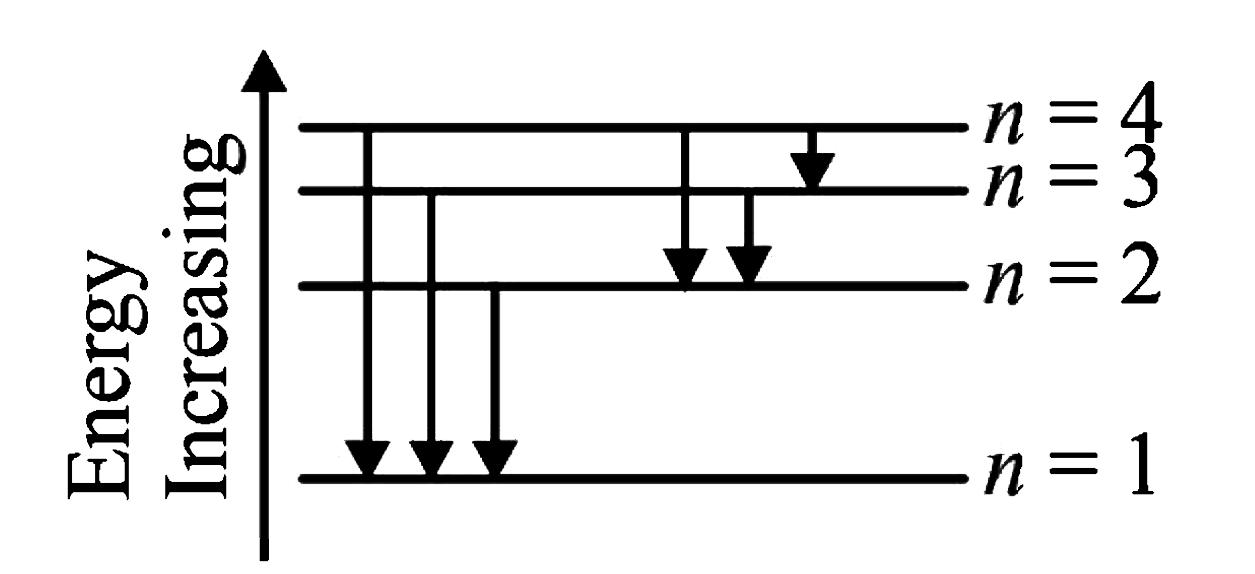Hydrogen atom is ground state is excied by mean of monochromatic radiation of wavelength How many asume different lines are possible is the resulting spactrum ? Calculate the lorgest energy for hydrogen atom as
The correct Answer is:A, B, C
13.6 [(1)/(n_(1)^(2)) -(1)/(n_(2)^(2))] = 12.75 rArr [(1)/(1) - (1)/(n_(2)^(2))] = (12.75)/(11.6) rArr n_(2) = 4 6 .

Topper's Solved these Questions
- MODERN PHYSICSBOOK - SUNIL BATRA (41 YEARS IITJEE PHYSICS)CHAPTER - MODERN PHYSICSEXERCISE - MCQ (One Correct Answer
1 Videos
- ELECTROSTATICSBOOK - SUNIL BATRA (41 YEARS IITJEE PHYSICS)CHAPTER - ELECTROSTATICSEXERCISE - Comprehension Based Questions
2 Videos
- MOVING CHARGES AND MAGNETISMBOOK - SUNIL BATRA (41 YEARS IITJEE PHYSICS)CHAPTER - MOVING CHARGES AND MAGNETISMEXERCISE - MCQs(d )
1 Videos
Similar Questions
Hydrogen atom in its ground state is excited by means of monochromatic radiation of wavelength 975A∘. How many different lines are possible in the resulting spectrum? Calculate the longest wavelength amongst them.
View SolutionHydrogen atom is its ground state is excited by means of monochromatic radiation of wavelength 1023Å. How many different lines are possible in the resulting spectrum? Calculate the longes wavelength among them. You may assume the ionization energy of hydrogen atom as 13.6 eV.
View Solution
Knowledge Check
Hydrogen atom in this ground state is excited by means of monochromatic radiation of wavelength 975Å. How many different lines are possible in the resulting spectrum? Calculate the longest wavelength amongst them. You may assume the ionization energy for hydrogen atom is 13.6eV
ATotal number of lines in emission spectrum would be 6.BEnergy difference between 3rd and 4th orbit is 0.66eV.Clongest wavelength is emission spectrum would be 1.875μm.Dsmallest wavelength in emission spectrum would be 975Å.Hydrogen atom in its ground state is excited by means of a monochromatic radiation of wavelength 970.6Å. Different wavelengths are possible in the spectrum. After absorbing the energy of radiation, hydrogen atom goes to the excited state. After 10−8 s, the hydrogen atom will come to the ground state by emitting the absorbed energy.
The electron of excited hydrogen atom is in which of the following energy states?A2B3C4D5Hydrogen atom in its ground state is excited by means of a monochromatic radiation of wavelength 970.6Å. Different wavelengths are possible in the spectrum. After absorbing the energy of radiation, hydrogen atom goes to the excited state. After 10−8 s, the hydrogen atom will come to the ground state by emitting the absorbed energy.
Energy absorbed by hydrogen atom isA1.82 eVB2.18 eVC8.12 eVD12.8 eV
Hydrogen atom in its good state is excited by means of monochromatic radiation of wave length 975A∘. How many different lines are possible in the resulting spectrum ? Calculate the longest wavelength among them. You may assume to ionization energy of hydrogne atom as 13.6eV.
View SolutionHydrogen atom in its ground state is excited by means of monochromatic radiation of wavelength 970.6Å. How many lines are possible in the resulting emission spectrum ? Calculate the longest wavelength amongst them. You may assume that the ionisation energy for hydrogen atom is 13.6 eV. Given Planck's constant =6.6×10−34Js, c=3×10(8)ms−1
View SolutionHow many hydrogen atoms in the ground state are exited by means of monochromatic radiation of wavelength 970.6 Ã…. How many different lines are possible in the resulting emission spectrum? Find the longest wavelength among these .
View SolutionH atom in its ground state is excited by means of a radiation of λ=970.6 Å. How many different wavelengths are possible in the resulting emission spectrum ?
View SolutionHydrogen atom in its ground state is excited by means of a monochromatic radiation of wavelength 970.6Å. Different wavelengths are possible in the spectrum. After absorbing the energy of radiation, hydrogen atom goes to the excited state. After 10−8 s, the hydrogen atom will come to the ground state by emitting the absorbed energy.
Number of different wavelengths present in the spectrum
View Solution
